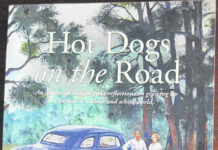ARTS SCENE
In 1953, author Ray Bradbury published the classic novel “Fahrenheit 451,” a fictional tale about a society where books are destroyed to keep people happy rather than allow them to form their own opinions. Seventy years later, Bradbury’s radical fiction is closer to reality than the author might have imagined.
Last year, more books were challenged in U.S. libraries and schools than any other time in the past two decades that data has been tracked. More than 2,500 books were targeted, according to the American Library Association, nearly double the rates of 2021. In 2019, there were 566 reported challenges, demonstrating an exponential rise in targeted materials.
Banning books is not a new thing. Censorship of art and literature has been happening for centuries in America. According to the ALA, family values, religion, political views, and minority rights are the four main drivers of censorship. However, the increase over the last few years is a trend that should alarm every American.
It goes without saying that not everything is for everyone. Literature, like art, is subjective, and the same can be said for our individual content preferences. It’s reasonable to believe that some information offends some while not others; however, isn’t there a better solution than simply destroying what we’re afraid of? Should we throw out the proverbial baby with the bath water?
The ALA says parents initiate half of the challenges. Understandably so, they are the guardians and primary information gatekeepers for their children. But not other people’s children, and this is a fundamental root of the censorship problem. Earlier this year a challenge was made to the county school board requesting that a book about Islam be removed from the library because the concerned parent didn’t want his child exposed to a religion outside his own. If that book had been banned, it would have been to the detriment of other children who might have gleaned something useful from learning about a culture unfamiliar to their own.
Library patrons make up another 20 percent, followed by school boards, political and religious groups, teachers, and elected officials. Most targeted are books deemed to be sexually explicit or that contain language considered to be age inappropriate. Racism, sexism, politics, violence, and cultural insensitivity are also why some books are challenged. In most cases, books with controversial topics are not arbitrarily placed on shelves, rather they’ve been vetted through an extensive process that weighs their value to the respective community.
Book challenges are more complicated than they appear. First, libraries are community resources, and everyone has the same right to information. Every citizen also has the right to question materials they deem to be inappropriate, and every library should have a collection
development policy that is available upon request that should clearly explain why materials are in the collection. At this stage, the decision to engage or not with certain materials is a freedom of individual choice.
While there are some reports of books being banned without due process, there are procedures for how materials are evaluated for removal. There are cases, however, when administrators ignored guidelines and removed books anyway, and in all fairness, this should never happen, especially if these materials were carefully selected for inclusion based on the library’s policies.
Many challenges end with a conversation. Again, individual values are often the lens through which materials are challenged, not the collective values and standards of the community. It becomes a case of “I don’t like it, so I want it removed.” A polarization of community standards can lead to disagreement about what is and is not appropriate, despite objective policies that outline how materials are curated. What might be inappropriate to one parent may be completely different for another, and here a parental guidance decision should be a mitigating factor in what a child accesses.
Materials challenged for sexual content (the majority) are often misleadingly labeled “obscene,” and it’s worth noting that while obscenity is not protected under the First Amendment, the Supreme Court has a three-point method, called the Miller Test, that considers visual depictions, words, and text to make this determination. Calling something obscene doesn’t always make it so.
What cannot be quantified in many challenges is history, context, and perspective. Take, for example, “To Kill A Mockingbird,” banned for its use of racist language. Published in 1960, few would argue that the inclusion of derogatory words was done with racist intention. Rather, taking the book at historical face value, Harper Lee’s novel provides a valuable lesson about race in America for young adults. Frankly, by today’s media standards, the language in Lee’s book is a walk in the park compared to what young people see on social media. But to make a point, sometimes a candid lesson in race relations makes the best lesson.
Ironically, banned books are more popular than ever before. In fact, the first week of October is dedicated to Banned Books Week, and bookstores across the country capitalize on media attention given to challenged titles. “To Kill A Mockingbird,” “The Adventures of Huckleberry Finn,” “The Color Purple,” “Of Mice and Men,” and Bradbury’s “Fahrenheit 451” all get celebrated and advertised to new audiences. Coincidentally, last year one of the country’s most challenged books, one on gender and sexuality, saw a 130 percent increase in sales.
Ray Bradbury wrote “Fahrenheit 451” in protest of censorship, and he is quoted as saying, “I am a preventer of futures, not a predictor of them. I wrote ‘Fahrenheit 451’ to prevent book-burnings, not to induce that future into happening, or even to say that it was inevitable.” If he were alive today, one can only wonder if he’d be surprised or if he’d say “I told you so.”
James Bass is the executive director of the Givens Performing Arts Center. He can be reached at [email protected] or 910-521-6325.








